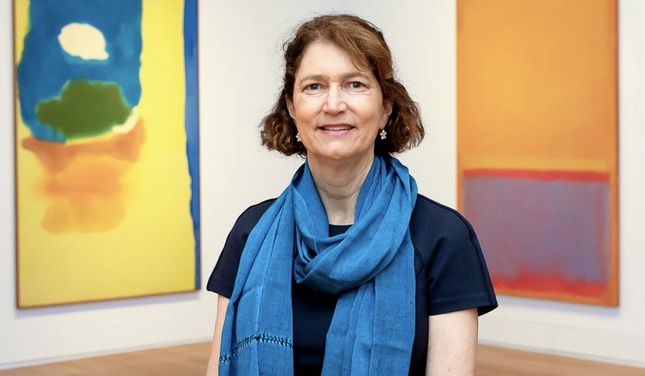
Jessica Smolinski
Art Gallery director Stephanie Wiles is working to expand the accessiblity of the university’s collection.
View full image

Jessica Smolinski
Art Gallery director Stephanie Wiles is working to expand the accessiblity of the university’s collection.
View full image
To find Stephanie Wiles, director of the Yale University Art Gallery, you have to go not to the gallery itself but down Chapel Street, to a third-floor corner office above the Union League Café. During a 2012 renovation, most of the staff offices were moved out of the gallery’s three adjoining buildings to make room for displaying more of its 185,760 objects.
Getting more of the collection in front of the public—both in person and online—has been a big part of Wiles’s mission since she came to Yale in 2018. Wiles was recently appointed to a second five-year term, and she’s continuing on the same path.
Much of her first term, of course, was taken up by the pandemic, which kept the gallery closed to the public for a year. Wiles says the museum took the opportunity to reinstall much of its permanent collection, and like many organizations, it learned how to do more online. “We realized we had really underinvested in digital resources,” she says. They redesigned the gallery’s website to make it more mobile-friendly, putting its out-of-print catalogs online and making them freely available to everyone. They also moved their lectures and classes online during the pandemic, something they are now continuing. “We can reach people across the globe,” she says.
Making the collections more accessible online is one thing; making it easier to see more of it in person is another. Since the university’s acquisition of the West Campus in 2007, the gallery and other Yale collections have been taking advantage of the elbow room on that 136-acre site to create space where objects can be easily available to students, faculty, and curators. The gallery is preparing to consolidate its offsite storage (some of which is now at the Library Shelving Facility in Hamden) on West Campus, including a new building for storing paintings and other large-scale works. “Downtown is where our masterpieces are,” says Wiles, “and West Campus is the research arm.”
Wiles, an art historian whose own research focused on pre-Raphaelite prints and drawings, spent 17 years at the Morgan Library before taking three successive jobs in college art galleries: at Wesleyan, Oberlin, and Cornell. “I grew up on a college campus—the Bard College campus,” she says. “Being involved in a university is really important to me, and once you get into it, I don’t think you leave it. It’s so exciting to have students around, to have them working with you.”
Asked what one thing a first-time visitor to the gallery ought to see, she diplomatically gives a three-part answer. “For the uniqueness of Yale, the John Trumbull paintings that are the cornerstone of the American collection,” she says. “For the blockbuster event, go to the Van Gogh Night Café, and then just for sheer amazement, the collection of Italian old master paintings is unparalleled. It’s a deep dive into early Italian art.”
 loading
loading
1 comment
-

Alan Stamm, 3:38am June 23 2023 |  Flag as inappropriate
Flag as inappropriate
The comment period has expired.In my 3rd undergraduate year, I took an utterly wonderful introductory course in Graphic Art History --taught by marvelous Professor of Art History, Theodore Sizer.
It began what for me became a lifelong interest in -- and an eventual collection of -- graphic art, especially etchings and lithographs.